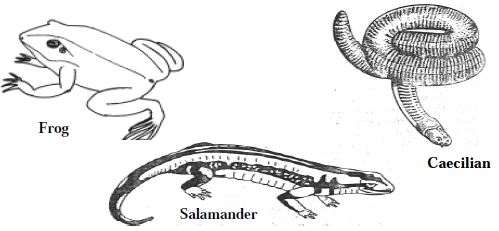The living representatives of class Amphibia include frogs, toads, newts, salamanders and limbless caecilians.

Fig: Amphibians
The transition from aquatic to terrestrial living is clearly indicated in the class Amphibia. These were the first vertebrates to live on land. Amphib-ians are not completely land adapted. They hover between aquatic and land environments. This double life is expressed in their name, amphibia. It is because of, these reasons ‘the amphibians are considered, a defeated group’.
The body forms vary greatly from an elongated trunk with distinct head, neck and tail to a compact, depressed body with fused head and trunk and no intervening neck. The forelimbs of frogs and toads are smaller than hind limbs. In frogs, hindlimbs have webbed feet. The surface of the skin is smooth and slimy. The slimy nature is due to the presence of mucous secret-ing glands. Scales are practically absent.
The mouth is usually large with small teeth in upper or both jaws. The external nostrils communicate into the anterior part of the mouth cavity. Respiration is effected by gills, lungs, skin and pharyngeal region. The heart is three chambered with two auricles and a single ventricle. The skeleton is mostly bony, with varying number of vertebrae: exoskeleton is absent. Sexes are separate. Fertilization is either external or internal. The tadpole Metamorphoses into adult.
Examples : Frog, Toad, Salamander, Caecilian.











